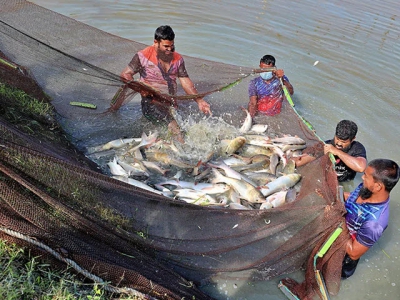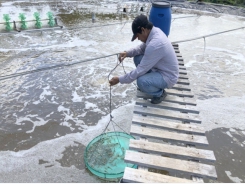Nine ways to produce more sustainable and affordable blue food - Part 2

3. Farm technologies and practices
Traditionally, aquatic animal farming has been dominated by ponds, floating cages, fixed cages, and reservoirs for freshwater finfish and crustaceans; brackish water ponds for euryhaline crustaceans and finfish; and coastal marine floating cages, rafts, and longlines for finfish, crustaceans, and bivalves. In some locations, increasing competition with other users, stringent regulation, negative public perception, and/or rising global temperatures are limiting expansion of aquaculture. Improved profitability is, however, driving most aquaculture systems toward intensification.
Intensified production implies increasing reliance on formulated feeds and can involve higher costs related to maintaining water quality.
Intensification also often increases environmental impacts such as eutrophication and risks of diseases and pests, motivating promotion of recirculating land-based systems (RASs) and offshore ocean farming.
These systems are, however, generally costly to acquire and operate, and therefore mainly promote luxury species. High electricity and fuel dependency for operating these farms will also necessitate renewable sources of energy to avoid environmental life-cycle trade-offs.
Unless there are paradigm shifts toward clean energy generation, the bulk of future finfish and crustacean farming will most likely continue to rely on farming in ponds, with a continued trend toward intensification.
These systems could, however, be greatly improved through better management practices, improved system design, and efficiency. Better record keeping, ideally supported by water quality sensors, diagnostics, and monitoring, could be key here, allowing farmers to optimize production and improve feed and chemical use. Integration with additional species and/or agriculture may further improve sustainability outcomes and help maximize production through better utilization of feed and by-products, which could mitigate nutrient emissions per unit of farmed output.
Constructing efficient settlement ponds that allow for the reuse of nutrients could further reduce eutrophication impacts, but might require additional land. As for all fed aquaculture systems, access to quality feed from sustainably produced resources will be key for profitability and environmental performance.
4. Spatial planning and access
Access to affordable land and/or water for farming is critical for profitable aquaculture, which is why many previously unclaimed areas, such as lakes and mangrove forests, have historically been exploited. When left unregulated, such exploitation easily results in environmental degradation (including mangrove deforestation and eutrophication) and disease outbreaks. It may also lead to privatization of public lands and/or raise public criticism. Developing well-designed spatial plans would help protect essential ecosystems, respect ecosystem carrying capacities, and increase overall farm profitability. These plans need to account for the right set of indicators and stakeholders and ensure enforcement.
5. Disease reduction
Disease is identified as a major obstacle for future expansion of aquaculture, with potentially serious environmental, economic, and social impacts worldwide. Global losses from infectious disease have been estimated to cost the global aquaculture industry US$6 billion annually, with mortality in some families of species, such as shrimp, sometimes exceeding 40%. It is also a major driver of excessive antibiotic use and poor animal welfare. Apart from choosing tolerant species and spatial planning, disease risks can be reduced through a range of interventions, from simple biosecurity measures and better hygiene to development of vaccines and the use of specific-pathogen-free and resistant seeds. These interventions are especially important for intensive systems, as the risks of disease ultimately are determined by stocking and/or farm density.
6. Feed
Fish resources from reduction fisheries and processing (i.e., transformed into fishmeal and oil) are nutritionally and palatably optimal for most fed aquatic species. Fisheries targeting such small pelagic fish also tend to have low carbon footprints. However, maximizing direct human consumption of this large fish resource (approximately 22% of global catches) should be prioritized where demand exists or can be cultivated, given that this would be a more efficient use of nutrients. Fish and other aquatic species used for feed may also come from overexploited stocks, be harvested using destructive fishing methods, and/or risk undermining marine food webs. For this reason, feed resources should be sourced only from sustainably certified sources. There is an increasing move to certify feed resources, such as the IFFO marine ingredients responsible sourcing standard and Aquaculture Stewardship Council (ASC) Feed Standard—something that may promote improved stock management but does not necessarily lead to more efficient use of these resources.
Fish proteins have been challenging to replace in the diets of higher-trophic-level species, but several alternatives have been developed, including livestock by-product meals, insect meals, terrestrial plant-based ingredients, macro- and microalgae, and precision formulations using synthetic amino acids. Many of these have, however, raised sustainability concerns, with livestock by-product meals transferring burdens associated with livestock production, agronomy being associated with land use and land-use change, and micronutrient supplements often having proportionately large carbon footprints.
In addition to being environmentally sustainable, alternative novel feed ingredients need to be cost effective, available in sufficient quantities year round, nutritious, free from contaminants and other undesirable compounds, able to endure a range of forms of processing, palatable to farmed aquatic organisms, and able to support the desired nutritional traits of seafood such as omega-3. Moreover, from a broader ethical perspective, these resources should not compete with demand for direct human consumption and nutrition, i.e., being food-grade resources. Terrestrial feed components (i.e., crop-based ingredients) are now being considered in certification schemes such as those operated by the ASC. In Table 2 we summarize the three most promising novel protein sources for aquafeed, their strengths, and their shortcomings. These were short-listed based upon their potential for upscaling, economic viability, and sustainability.
Table 2: Strengths and shortcomings of three promising novel protein sources for aquafeed
| Protein source | Strengths and shortcomings |
| Fish processing by-product meals | While already partially utilized, an estimated 8 million tonnes of fishmeal could potentially be available at an affordable price if more fish by-products from processing were utilized in fishmeal production globally. Environmental impacts are, however, dependent on the supporting fishing, farming, and processing activities from where the resources derive and from which environmental burdens need to allocated. There are also potential risks of bioaccumulation of toxins and spread of disease. |
| Insect meals | Insect production represents a promising way to recycle slaughter- and plant-derived waste streams into feed resources with good nutritional profiles. The organic rearing substrate, however, along with the energy required to produce and process the insects, largely determines the environmental performance of the insect meals. Many are not yet financially competitive, and global production output potentials are questionable, but efficiency gains from scale and new innovations could still be realized. |
| Single-cell organisms | These comprise a diverse group of bacteria, microalgae, and yeasts that are autotrophic or can be grown on a variety of organic materials, including fiber sludge from the forest industry or methane. Production costs remain well above those of fishmeal and fish oil, but economies of scale and improved production practices are steadily being realized. In addition, their potential to support maintenance of omega-3 profiles while replacing proteins and fish oil makes them attractive. |
Macroalgae have also been suggested as suitable aquafeed ingredients, but variable nutritional content and digestibility problems for fish suggest that only a small fraction of feed ingredients can be substituted at the scale needed. Energy requirements for desiccating macroalgae and by-product meals can also be high.
Ultimately, the formulation of compound feed changes on a day-to-day basis, where the final product will be a combination of complementary raw materials sourced based upon nutritional profile and market price. Feed ingredients must therefore be considered through the interacting nutritional effects of the feed as a whole. Interactions with other markets also need to be factored into this equation, as the same set of feed resources is used in terrestrial animal production, and sometimes feed resources compete with direct human consumption or for agricultural land. In other cases, prices might be driven up by demand from more profitable commodities, such as omega-3 food supplements or biofuels. Thus, interactions in the feed-food system need to be considered in their entirety, but the environmental impacts related to individual feed resources need to be considered (using, e.g., fao.org/gleam) and communicated when formulating feed, accompanied by a continued drive toward reducing FCRs.
7. Regulations and trade
Various public and private regulatory frameworks have been initiated by governments and non-government actors to regulate some of the social and environmental problems of aquaculture development. Driven by non-governmental organizations (NGOs) and media campaigns, third-party certification schemes have been widespread among seafood commodities and potentially have the power to push industries toward more sustainable practices. However, the role of certification remains limited, and the standards of the two largest certification groups—ASC and the Global Aquaculture Alliance Best Aquaculture Practices (GAA-BAP)—cover only 3% of global aquaculture production. Many of the best established private certification schemes, however, mainly cover luxury aquatic food species, fail to consider interspecies differences, and mainly address the concerns of Western consumers. Certification standards consequently need to become more comprehensive and consider a broader set of life-cycle impacts, as certifying common practices or targeting certain traits (e.g., organic) may not push production toward overall better practices.
A prerequisite for changing the seafood industry through certification and consumer choices is value-chain upgrading and alignment to ensure product traceability. Based on DNA barcoding, it has been reported that as much as 30% of all traded seafood is incorrectly labeled as other species. Mislabeling can be unintentional, through misidentification and confusion over common names, but most is probably deliberate, with the ambition to achieve higher market prices or to market unsustainably or illegally harvested species. Given such widespread mislabeling for a characteristic as fundamental as “species,” it will be difficult to assign trustworthy environmental profiles to aquatic foods. Better documented trace-back systems are an effective countermeasure here, and there are currently several initiatives for tracking seafood using blockchain technology (e.g., fishcoin.co and traceability-dialogue.org). Traceability schemes are, however, only as effective as the initial data entered.
Regulations can address more comprehensive sets of farms and farming practices, but have also been seen as a barrier for potential grow-out sites, therapeutics, access to fresh water, effluent discharge, and the use of genetically modified organisms (GMOs), non-indigenous species, and novel feed ingredients.
Too stringent and/or inflexible regulations are also often blamed for impeding aquaculture in Europe and the United States, and newly introduced environmental regulations in China and elsewhere have resulted in the closure of farming systems in lakes and reservoirs. Regulations should thus be drafted to discourage detrimental farming practices, without hampering otherwise effective interventions.
Có thể bạn quan tâm
Phần mềm

Phối trộn thức ăn chăn nuôi

Pha dung dịch thủy canh

Định mức cho tôm ăn

Phối trộn phân bón NPK

Xác định tỷ lệ tôm sống

Chuyển đổi đơn vị phân bón

Xác định công suất sục khí

Chuyển đổi đơn vị tôm

Tính diện tích nhà kính

Tính thể tích ao hồ



 Nine ways to produce more sustainable and affordable…
Nine ways to produce more sustainable and affordable…  Nine ways to produce more sustainable and affordable…
Nine ways to produce more sustainable and affordable…